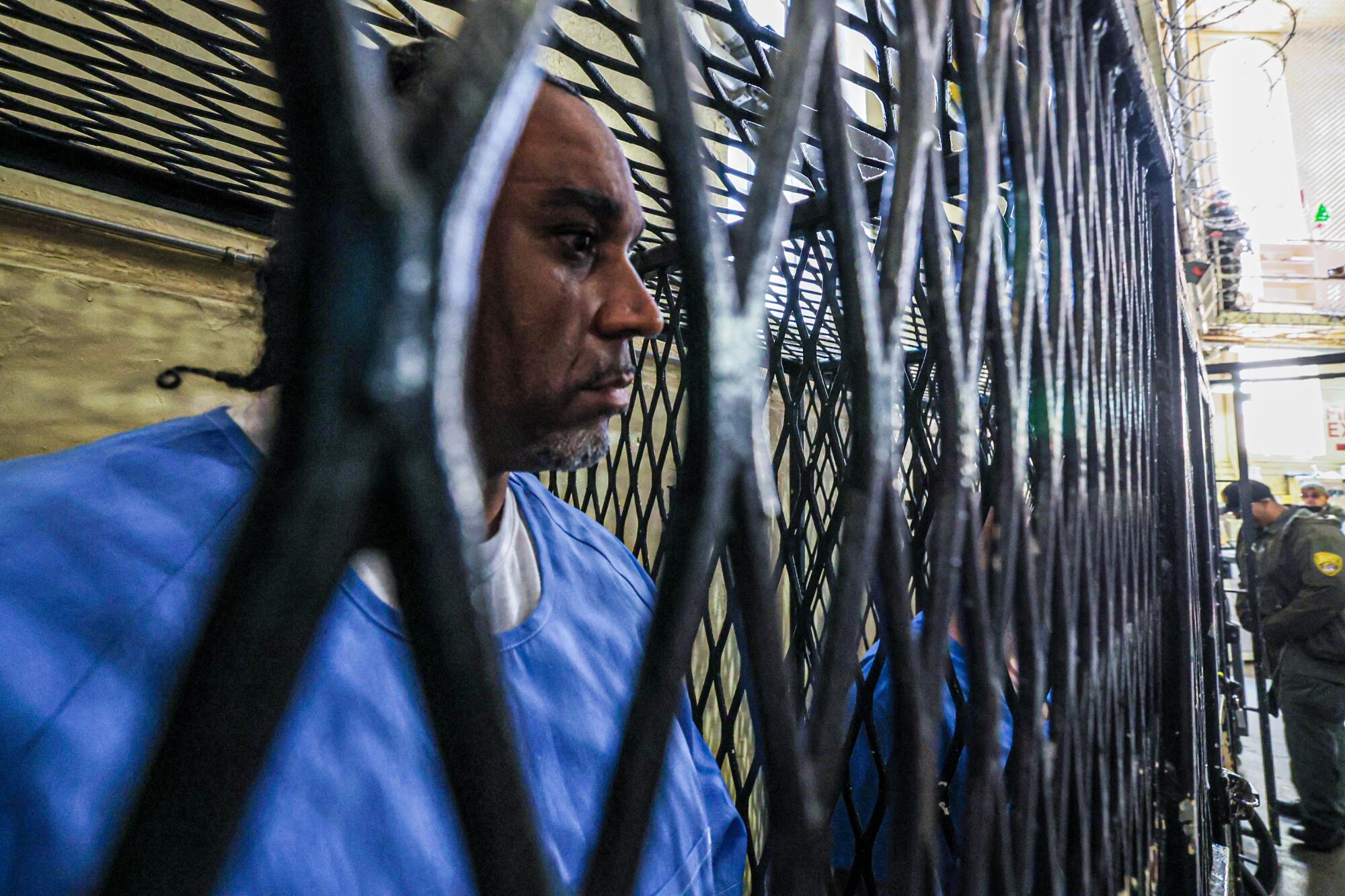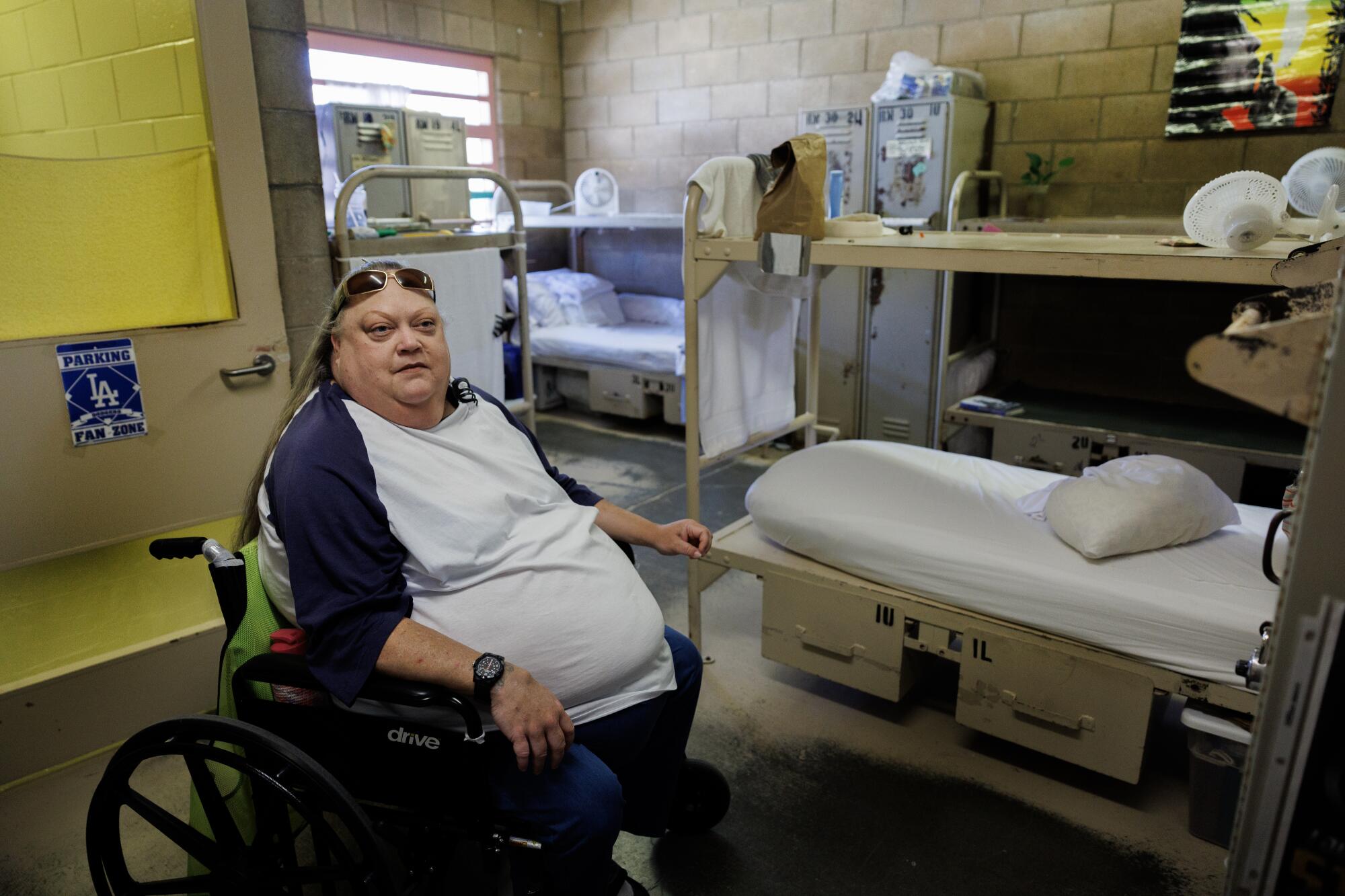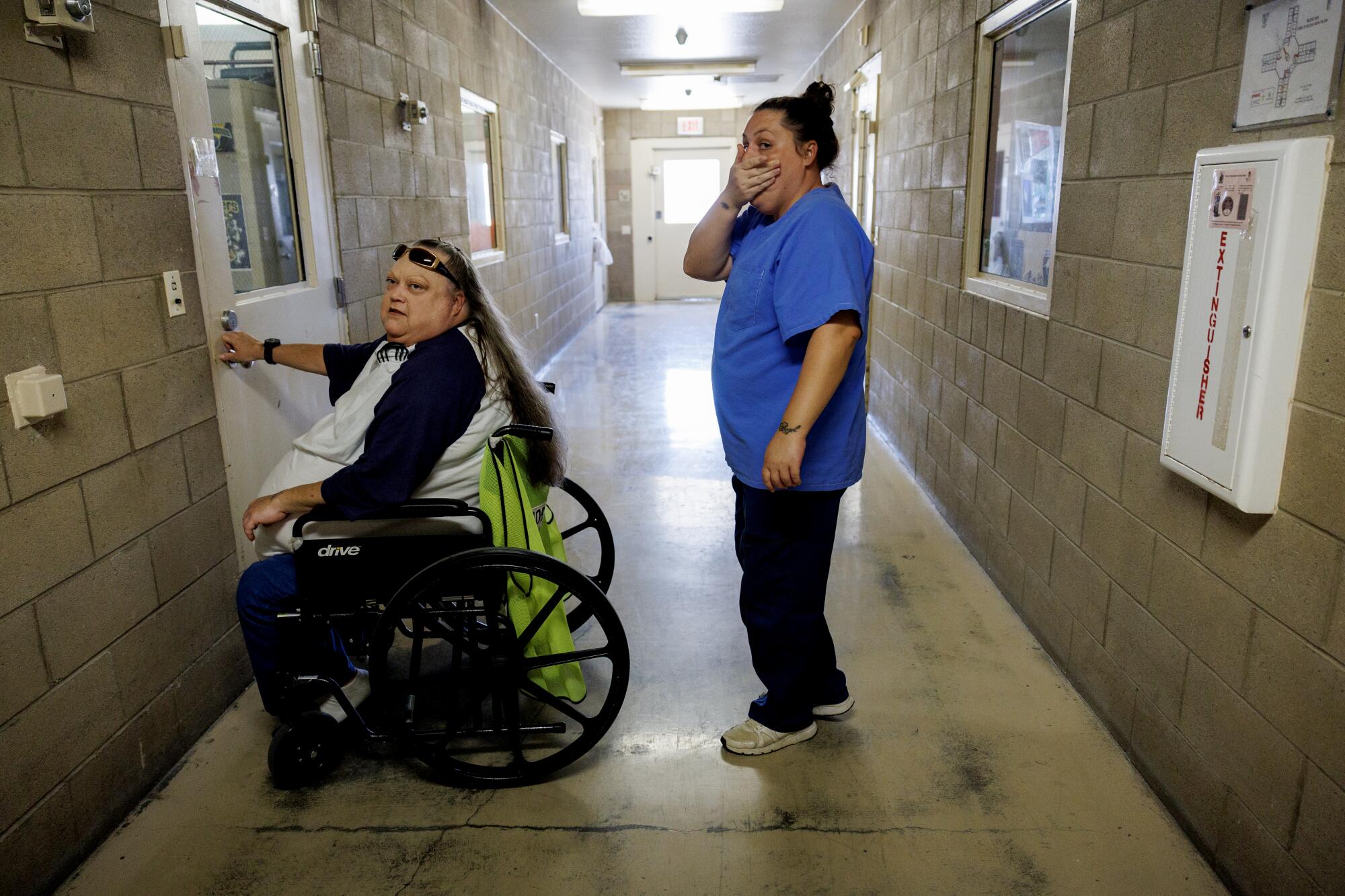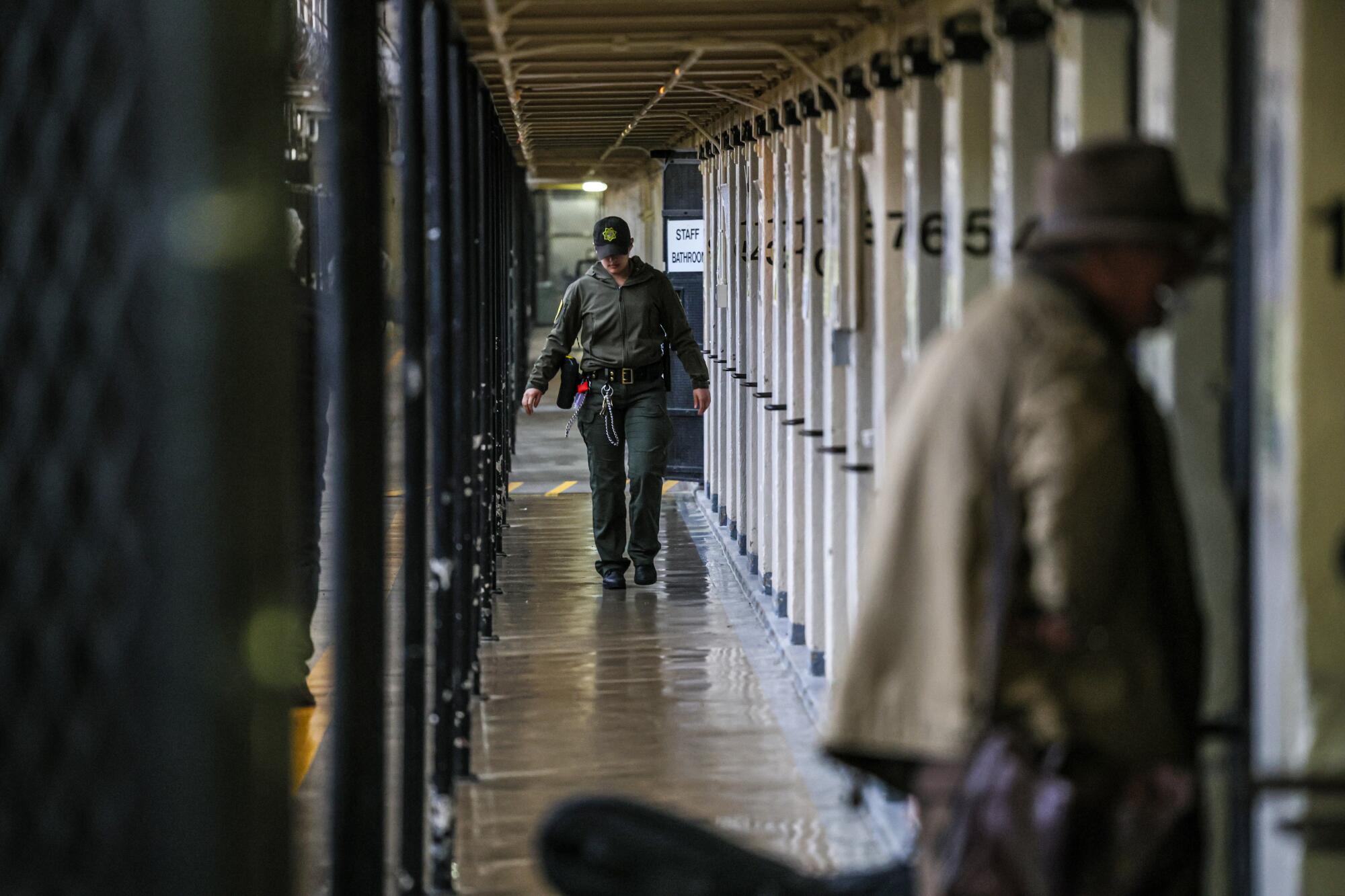-
The U.S. Right Loathes the E.U. How Are They Going to Negotiate Trade? - 18 mins ago
-
How To Prepare for Hurricane Season 2025, According to Experts - 24 mins ago
-
Moms Are Trying To Delay Daughters’ First Period—Experts Say They’re Right - 59 mins ago
-
What to Know About Poland’s Presidential Runoff Election and Trump’s Involvement - about 1 hour ago
-
List of Stores Closing in June - 2 hours ago
-
South Korea’s Election Likely to Reset Ties With China - 2 hours ago
-
List of Walgreens Stores Closing This Month - 2 hours ago
-
Train Derails in Western Russia After Bridge Collapse, Killing at Least 7 - 3 hours ago
-
How to Watch Pacers vs Knicks Game 6: Live Stream NBA Eastern Conference Finals, TV Channel - 3 hours ago
-
Transgender track athlete wins gold in California state championships despite Trump threat - 3 hours ago
Life after California’s death row: Condemned inmates get second chance

A condemned inmate is led to his cell on San Quentin’s death row.
(Robert Gauthier / Los Angeles Times)
SAN FRANCISCO — By age 46, Bob Williams had spent more than half his life in isolation, waiting to die on San Quentin’s death row.
Williams was 18 when he raped and murdered 40-year-old Mary Breck at her Kern County home in October 1994. The day before, he had broken into Breck’s home and stolen her credit cards. He returned — initially with the intention of giving the items back, he said — but instead brutally assaulted and strangled Beck, leaving her gasping for air in her bedroom before he went back to finish the killing. He was convicted of first-degree murder and sentenced to death.
By that point, Williams had spent his youth cycling through juvenile hall and foster homes. Sad as it may sound, he said, getting sent to San Quentin “was the best thing that ever happened to me.”
“I went to prison with the idea of No. 1, finding God, and if I could find God, find some kind of forgiveness if it was available,” Williams said.
On death row, he built a life amid the dank cells of concrete and iron stacked five stories high. He soaked up books on philosophy and spirituality, finding solace in the poem “Invictus.” He had come to terms with his death sentence, the prospect of lethal injection always looming, when due to political churns out of his control, San Quentin’s death row was itself declared at an end. Over the last five years, its cells have been systematically emptied and its condemned men dispersed to other prisons.
In the spring of 2022, Williams was uprooted from his solitary world and transferred to a prison in San Diego County. There, for the first time in decades, he would eat with other men and walk among them in the prison yard, feeling sunlight on his face.

The state has transferred hundreds of condemned men from San Quentin’s death row to other prisons as part of a plan to transform the facility into a model for rehabilitation.
(Robert Gauthier / Los Angeles Times)
Now 49, Williams is still condemned to die. But under a series of executive actions ordered by Gov. Gavin Newsom — his 2019 moratorium on executions and his 2023 pronouncement that San Quentin would be transformed into a model for rehabilitation — it is unlikely that any of the 588 condemned prisoners in California will be put to death in the near future.
Newsom’s directive to dismantle death row did not alter the sentences for condemned men and women. But it did dramatically upend their lives. Hundreds of death row inmates from San Quentin have been scattered among two dozen institutions across the state, while the 18 condemned women who had been housed in the isolated death row at the Central California Women’s Facility in Chowchilla were moved into general population housing at the same prison.
The transfers ushered in new freedoms for the inmates, who on death row typically spent more than 20 hours a day in single cells covered with metal mesh that filtered out sunlight. They were handcuffed and escorted by armed guards anytime they left their cells. They largely ate alone and exercised in small groups. They had little, if any, access to classes and rehabilitative programming.
When it was Williams’ turn to leave, he left most of his belongings behind, passing out some of his books and giving a guitar to one friend, his art supplies to another. He packed his Bibles and prayer books and a few pieces of prison-approved clothing. Then he boarded a van and traveled roughly 12 hours south to the Richard J. Donovan Correctional Facility in San Diego County, where he found meaningful work as a chapel clerk.

A condemned inmate makes a phone call from his cell on San Quentin’s death row.
(Robert Gauthier / Los Angeles Times)
Williams marveled at the coastal sunsets, and stopped to pick grass in the prison yard just so he could smell it. On the yard, he played softball and basketball like he was a teenager again, welcoming the body pains that came with vigorous exercise.
There were also uncomfortable adjustments. He was eventually assigned a cellmate, which made him uneasy at night. And many of the guards and other inmates seemed wary of sharing space with men sentenced to death.
“It’s a transition,” he said. “And it’s a hard transition sometimes.”

San Quentin, long home to California’s most notorious criminals, is being reimagined as a prison focused on preparing offenders for reentry into society.
(Robert Gauthier / Los Angeles Times)
Even as prison reform advocates have celebrated Newsom’s efforts to abolish capital punishment and rebrand San Quentin as a place of hope and transition, groups representing crime victims and their families have responded with a mix of fury and weary resignation. They accuse him of ignoring California voters, who have routinely rebuffed efforts to end executions, including in 2016, when they rejected a statewide ballot measure that would have repealed the death penalty.
“Death row was voted [on] by the people of the state of California. And one individual, the governor, by a swipe of a pen decided to take it away and end it,” said Patricia Wenskunas, founder of Crime Survivors Inc. “He revictimized all of those family members that were promised and told that that individual would face death.”
The same year voters rejected the death penalty initiative, they narrowly passed a competing ballot measure, Proposition 66, aimed at speeding up California’s execution process by shortening the timeline for legal appeals. But a little-known provision of Proposition 66 allowed the state to house condemned inmates in other prisons, where they would be required to hold prison jobs and pay 70% of their income to victims.
Though perhaps unintended, it was this provision that allowed the Newsom administration to empty death row. And, on paper at least, state prison officials have touted the transfers as a success.
They note that hundreds of condemned inmates have contributed more than $229,000 in restitution since January 2020, when the transfers began.
Seventy percent of the transferred inmates are now taking part in rehabilitative programs, according to the California Department of Corrections and Rehabilitation. More than 330 are enrolled in educational courses, and 263 are involved in self-help classes.
On the other hand, 99 condemned inmates have faced discipline “for serious violations,” according to the department. Still officials said, most of the transferred prisoners are showing a decline in disciplinary points on their records, which means “they’re engaging in programming options and have generally good behavior.”
For the prisoners, the transfers have brought a broad variety of experiences and emotions.
Many had grown accustomed to the solitude of death row, its stale smell and the frequent rants from inmates in mental health crisis. They lived alone, with set times for meals, yard access and showers.
Some condemned inmates still live in single cells in their new accommodations, but others have been assigned cellmates or live in dormlike settings. At some prisons, meals are shared in the chow hall. So the transition has meant adjusting to group settings and all they entail: more people, eye contact, conversation, confrontation.
Kevin Bernoudy, 46, was sentenced to death for a 2006 gang-related murder in L.A. County. He has struggled in his first year at California State Prison Solano, where he was transferred to bring him closer to his wife, whom he married in 2023.

Death row was harsh, but came with a sense of order, says inmate Kevin Bernoudy. Transferring into the general prison population has meant interacting with young guys, some with attitudes.
(Robert Gauthier / Los Angeles Times)
Death row was harsh, but also came with a sense of order and many of his fellow prisoners had grown old behind bars. Moving to the general population meant interacting with young guys, some of them with attitudes.
Bernoudy said he got into an altercation with some younger inmates in the summer last year. “They don’t want no structure. They don’t want to stop using drugs…. They don’t want to do nothing to help themselves,” he said of the younger guys. “If this is our future, it’s terrible.”
Bernoudy hasn’t been given a job yet or enrolled in any classes, so his days now don’t look much different than they did during his decade at San Quentin.
But there have been perks.
Everyone on death row used the same nail clipper that a guard would hand them when they went to the shower, he said. Rather than use a shared clipper, Bernoudy said, he would “wait until the shower, and I’d just peel my own toenails off.”
At his new prison, inmates can buy their own razors and nail clippers from the canteen. And the food is better.
“They gave me a [chicken] leg, and to me that was like, wow,” he said. “We don’t get that on death row. You’re not allowed to have bones.”

David Carpenter, dubbed the Trailside Killer, was sentenced to death in 1984 for the murders of more than half a dozen people along Northern California hiking trails.
(Robert Gauthier / Los Angeles Times)
Among the condemned prisoners who have been transferred are people convicted of some of the most monstrous crimes in California history.
David Carpenter was sentenced to death in 1984 for the murders of more than half a dozen people along Northern California hiking trails between 1979 and 1981, a gruesome spree that earned him the nickname Trailside Killer. At 94, Carpenter is California’s oldest condemned inmate.
In interviews conducted by text in the spring of 2024, using a tablet provided by the prison, Carpenter said he was looking forward to his transfer to the California Health Care Facility in Stockton.
“The main reason for all of us is the FREEDOM [we] will be able to experience,” he wrote.
Carpenter uses a wheelchair and a walker, so he was housed in a single cell. He said he now gets a hot breakfast every day and enjoys much more time on the yard. He enrolled in a computer education program and is seeking out opportunities for interaction, such as attending prison church services.

A guard stands watch on San Quentin’s death row.
(Robert Gauthier / Los Angeles Times)
In September, Carpenter contracted COVID-19 and fell seriously ill. He was moved to an isolation unit for several days and recovered. It was a stark contrast to 2020, when more than a dozen death row inmates died as COVID swept through the ward.
“All of us San Quentin inmates see being here as being in a retirement home environment,” Carpenter said.
Raynard Cummings also said life was better since he left San Quentin, if only marginally.
Cummings, 67, was condemned to die for his role in the fatal shooting of LAPD Officer Paul Verna during a traffic stop in June 1983. Prosecutors said that as Verna walked up to his car, Cummings pulled out a gun and shot the officer, while his friend, Kenneth Gay, jumped out of the car and unloaded several more rounds into Verna. Both men were convicted in 1985 and sentenced to die, though Gay has since been resentenced to life without parole.
Last year, with the prospects of transfers looming, Cummings told The Times he was hoping to be sent to a prison that was wheelchair accessible and where he could get physical therapy for his arthritis. But he was also prepared for a more confrontational relationship with the guards.
“They’re going to see I’m in here for a cop killing, and they all feel some kind of way about it,” he said.
Last spring, Cummings was sent to a high-security yard at the state prison in Lancaster. When he arrived, Cummings said, he was mesmerized at seeing a full moon for the first time since 1983. But he’s been put off by what he describes as a general sense of chaos.
As of late fall, Cummings said he had not found a job or enrolled in any rehabilitative groups. Still, he was glad to be out of San Quentin.
“San Quentin was 10 times, a million times worse,” he said. “And they knew they could get away with it, because we were the worst of the worse, the despicable of the despicable.”
Like many of the condemned inmates, Cummings already has been transferred a second time, part of the ongoing prisoner shuffle as corrections officials manage space constraints and inmate security classifications. This year, he was transferred to High Desert State Prison in Lassen County.

“There were genuine friendships that were grown from there,” Cathy Sarinana says of the death row at Central California Women’s Facility. “We were like family.”
(Gina Ferazzi / Los Angeles Times)
Cathy Sarinana, 48, is one of 18 women condemned to die in California. She was wary at the prospect of leaving death row at the Central California Women’s Facility. Though set up like a “chicken coop,” Sarinana said, the women inside formed a supportive community. At times, “it was like high school,” she said, with cliques and bickering. But “there were genuine friendships that were grown from there. We were like family.”
Sarinana and her husband were convicted in 2009 of killing their 11-year-old nephew, Ricky Morales, on Christmas Day 2005 in Riverside County. Sarinana’s husband admitted to beating the boy before he died, and she was accused of ongoing abuse. Soon after Ricky was found dead, investigators found the body of his 13-year-old brother, Conrad, encased in concrete in a trash can in the family’s carport.
Sarinana said that her behavior was the byproduct of years of physical and emotional abuse by her husband. She agrees that she should be in prison, although she does not think she deserved a death sentence. More than anything, she said, she should have done more to protect her nephews.
“I still should have tried. And I live with that guilt every day,” she said.

Inmate Cathy Sarinana, left, worried about the judgment condemned women would face when moved off death row. “Everyone here has done crazy stuff,” Sarinana says.
(Gina Ferazzi / Los Angeles Times)
But on death row, Sarinana said, she found the acceptance she’d long craved.
The condemned women enjoyed a bit more freedom than the men at San Quentin, largely because there were so few of them. They were allowed to congregate in the unit outside their cells for some portion of each day.
She reminisced about the potlucks the women would throw to mark holidays. They had access to big pots of water they could heat with electric rods. At Christmas, they made tamales. For Thanksgiving, Sarinana would make rolls filled with meat and cheese. And to celebrate the wedding of Prince Harry and Meghan Markle, they fashioned fascinator hats out of cardboard and glitter.
Sarinana left the row in March 2024. She was transferred to a medical unit on the prison campus that accommodates prisoners, such as herself, who use wheelchairs.
She worried about the judgment the condemned women would face. Many had killed children, their husbands — or both.
“Everyone here has done crazy stuff,” Sarinana said. “We were worried about being shunned.”
It took months to acclimate to being around so many people. And after years of being cuffed when she left her cell, she didn’t know how to use her hands. Turning doorknobs was difficult.
But over time, Sarinana has warmed to her new environment. She works as a group facilitator with Velda Dobson-Davis, a retired chief deputy warden who now volunteers at the women’s prison, running programs focused on trauma.
Sarinana still has moments when she misses death row. Last Christmas, she was dealing with a difficult bout of depression. She remembered the games the women played during the holidays and their elaborate meals.
“I still crave that place,” she said. “It’s morbid.”

Many of the inmates transferred out of death row had grown used to the relative solitude. The transition to new prisons has meant adjusting to group settings and confrontation.
(Robert Gauthier / Los Angeles Times)
Williams, the inmate who was 18 when he committed the crime that sent him to death row, said his new lease on life is similarly bittersweet. Last year, he was moved again, this time to the California Health Care Facility in Stockton. He doesn’t like it as much as Donovan, but it’s still better than death row.
As time passes, he finds himself wishing Newsom would do something more for condemned prisoners, especially those who were his age when they were sentenced. “I’m kind of at a point of, either execute me or tell me you’re not going to,” he said.
He allows himself to nurture a sliver of hope that one day he could be resentenced and released. But he’s still at peace with the notion of dying behind bars — whether from age, or execution.
“I’ve come face to face with it, and I’ve looked it in the eye,” he said. “And I found life.”
Times researcher Cary Schneider contributed to this report.
Source link





















